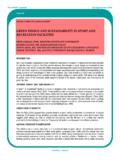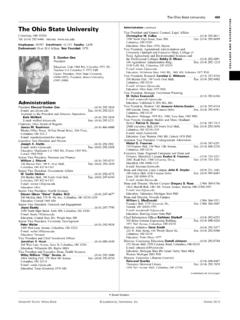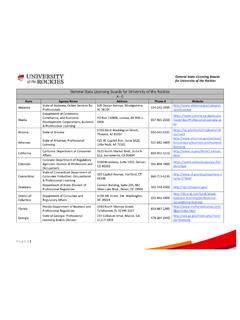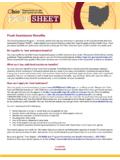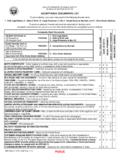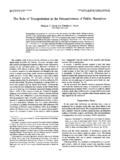Transcription of DEFINING ALTRUISTIC LEADERSHIP IN THE …
1 ABSTRACT ALTRUISTIC LEADERSHIP is defined as guiding others with the ultimate goal of improving their wellness. Research on ALTRUISTIC LEADERSHIP in coaching has not been published. This study explored intercollegiate coaches perceptions of ALTRUISTIC LEADERSHIP . The findings from the participants responses to interview questions are presented. An analysis was enacted to determine similarities and differences among coaches responses. Fifteen NCAA Division I head coaches from the Midwest United states participated in this study. Seven coaches were female and eight were male. Eight coaches were from team sports, and seven were from individual sports. Their coaching experience ranged from 8 to 36 years. The average years of head coaching experience were 17 years. Results indicated that coaches perceived similar definitions for ALTRUISTIC LEADERSHIP in intercollegiate coaching.
2 The factors they included were (a) character, (b) caring, (c) empowerment, and (d) balance. These findings are discussed in relation to theoretical and empirical literature on altruism, LEADERSHIP , and motivation and in practical terms for higher education and sport management. DEFINING ALTRUISTIC LEADERSHIP IN INTERCOLLEGIATE COACHING Altruism is a motivational state with the ultimate goal of increasing another s well-being (Batson, 1991). No attempts have been made to apply an altruism framework to examine coaches motivation. The role of a coach as a leader within intercollegiate athletics has been criticized for rule violations and ethical problems to achieve the ultimate goal of winning (Byers, 1995; Simon, 1991; Sperber, 1990; Zimbalist, 1999). Critics of intercollegiate coaches have described their behavior as greedy and selfish.
3 These behaviors include: demanding high salaries, pushing to win at all costs, lacking time spent with players, breaking contracts, scalping tickets, focusing on their own income from summer camp revenue, and asking for bonuses based on wins in order to gain greater financial incentives (Byers, 1995; Sperber, 1990; Zimbalist, 1999). On the opposite side, research is lacking on coaches motivation to improve the wellness of their athletes. This would be defined as ALTRUISTIC LEADERSHIP in coaching. Due to the lack of literature on ALTRUISTIC LEADERSHIP , it is important to examine this understudied area of LEADERSHIP in intercollegiate athletics to determine if it exists, to what extent it exists, and how coaches define ALTRUISTIC LEADERSHIP . This study has the primary purpose of exploring coaches definitions of ALTRUISTIC LEADERSHIP in their profession.
4 The study is ALTRUISTIC LEADERSHIP is defined as guiding others with the ultimate goal of improving their wellness SM A RT Journa l Fall 2005 Volume 2, Issu e 1 Page 4 THE SMART JOURNAL DEFINING ALTRUISTIC LEADERSHIP IN THE MANAGEMENT OF INTERCOLLEGIATE COACHING LISA M.
5 MILLER, PHD, ASHLAND university , JANET S. FINK, PHD, THE ohio STATE university , DONNA L. PASTORE, PHD, THE ohio STATE university , ROBERT E. BAKER, PHD, GEORGE MASON university KEYWORDS: LEADERSHIP , COACHING, ATHLETICS The SMART Journal Volume 2, Issue 1 intended to provide a valuable resource for researchers and coaches interested in the wellness of student-athletes and LEADERSHIP motivation of coaches. LEADERSHIP IN INTERCOLLEGIATE COACHING Despite the dearth of literature on ALTRUISTIC LEADERSHIP , much research has been conducted on the conditions of intercollegiate coaching (Gaal, Glazier, & Evans, 2002; Leland, 1988; Martin, Arena, Rosencrans, Hunter, & Holly, 1986; Pastore, 1991; Pastore, Goldfine, & Riemer, 1996; Sabock, 1979). For example, Sabock (1979) discussed the roles that a coach must fill in intercollegiate athletics.
6 These roles included a teacher, disciplinarian, psychologist, mother, father, community citizen, university citizen, and role model. Unfortunately, coaches do not always serve as a good role model within these roles. Sperber (1990) wrote a section about coaches in his book on intercollegiate athletics, and this section was entitled Greed City. The author described many unethical and selfish behaviors of coaches. These LEADERSHIP problems in intercollegiate coaching are often reported in the media, such as rule violations, unethical decisions, and selfish overemphasis on winning. Others have reinforced the existence of these greedy problems in intercollegiate coaching (Byers, 1995; Simon, 1991; Zimbalist, 1999). Despite the focus on selfish behaviors, the paradigm of unselfish, ALTRUISTIC LEADERSHIP has not been studied as a contrast to selfish behaviors in intercollegiate coaching.
7 ALTRUISTIC LEADERSHIP is the guidance of others with the ultimate goal of improving their wellness. Unfortunately, few studies exist regarding ALTRUISTIC LEADERSHIP (Barker, 1997; Staub, 1991; Staub, 1992). Barker (1997) described ALTRUISTIC LEADERSHIP as a common higher calling to social compassion from a universal ethical conscious. This definition may apply within intercollegiate coaching for those coaches who have a higher motivation beyond performance records. Perhaps even a universal ethical conscious of helping student-athletes exists within the profession of intercollegiate coaching. Greenleaf (1992) referred to a similar form of LEADERSHIP called servant LEADERSHIP . He defined servant LEADERSHIP as social leaders who transcend self-interest to serve the needs of others. A difference between servant LEADERSHIP and ALTRUISTIC LEADERSHIP is the foundational components; servant LEADERSHIP is based on behaviors of helping and ALTRUISTIC LEADERSHIP is based on the motivation behind helping.
8 Further studies of ALTRUISTIC LEADERSHIP would facilitate the delineation and definition of the construct. The focus in this study is DEFINING ALTRUISTIC LEADERSHIP in intercollegiate coaching. This type of LEADERSHIP could be studied in the relationship between coaches and student-athletes in intercollegiate athletics. Coaches provide guidance for their student-athletes, and the motivation behind this guidance may or may not be ALTRUISTIC . Therefore, knowledge of ALTRUISTIC LEADERSHIP is important to investigate within intercollegiate coaching. The purpose of this study is to gather information from intercollegiate coaches regarding their perspectives on ALTRUISTIC LEADERSHIP in intercollegiate athletics in order to answer the research question of how is ALTRUISTIC LEADERSHIP defined in intercollegiate athletics METHOD PARTICIPANTS Participants were 15 (8 male and 7 female) NCAA Division I-A coaches from a large Midwestern university in the United states .
9 The range of coaching experience was 8 to 36 years with an average of 17 years of head coaching experience. Coaches represented both men s and women s teams, and individual and team sports. Participants were asked to respond to questions regarding ALTRUISTIC LEADERSHIP . They were ensured confidentiality of their identity. Data was reported with pseudo-names of the participants. INTERVIEW AND INTERVIEW GUIDE Coaches responded to questions in a semi-structured interview process. The interview followed an interview guide that was developed for this study. Each participant signed a form of confidentiality and responded to demographic The SMART Journal
10 Volume 2, Issu e 1 Page 5 SMART seeks to reach new educational horizons in the future Page 5 THE SMART JOURNAL The SMART Journal Fall 2005 Volume 2, Issue 1 survey questions prior to being interviewed.
